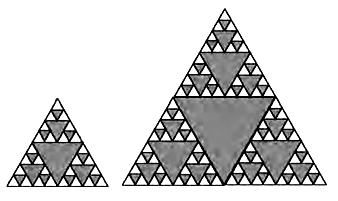


 الفيزياء الكلاسيكية
الفيزياء الكلاسيكية
 الكهربائية والمغناطيسية
الكهربائية والمغناطيسية
 علم البصريات
علم البصريات
 الفيزياء الحديثة
الفيزياء الحديثة
 النظرية النسبية
النظرية النسبية
 الفيزياء النووية
الفيزياء النووية
 فيزياء الحالة الصلبة
فيزياء الحالة الصلبة
 الليزر
الليزر
 علم الفلك
علم الفلك
 المجموعة الشمسية
المجموعة الشمسية
 الطاقة البديلة
الطاقة البديلة
 الفيزياء والعلوم الأخرى
الفيزياء والعلوم الأخرى
 مواضيع عامة في الفيزياء
مواضيع عامة في الفيزياء|
Read More
Date: 30-9-2016
Date: 3-10-2016
Date: 12-11-2016
|
Fractional Dimensions?
A point has zero dimensions. A line has one dimension. A plane has two dimensions. Space has three dimensions. Can something have 1.585 . . . spatial dimensions?
Answer
Yes. Non-integer dimensions are known as fractal dimensions. A pathway toward understanding fractal dimensions begins by considering duplications of well-known objects. A line segment can be duplicated to produce two line segments. A square can be duplicated in each direction to produce four squares. A cube can be duplicated in each of its three directions to produce eight cubes. In each case we obtain the number 2 raised to an integer power. We can make a table and generalize to d arbitrary dimensions.

We can now determine the dimension of an interesting but strange geometrical object, the Sierpinski triangle, named after the Polish mathematician who originally thought it up in 1916, shown here with its holes being gray. Double the length of the sides, and you get another Sierpinski triangle, similar to the first. For example, if the first Sierpinski triangle has one-inch sides, the doubled one has two-inch sides. How many copies of the original triangle do you have? Remember that the gray triangles are holes, so we can’t count them. Ignoring the hole in the center of the double-sized Sierpinski triangle,

we learn that doubling the sides of the original gives us three copies, so 3 = 2d, where d = the dimension according to the scheme in the table. Using a calculator, one finds that its dimension d = 1.585 . . . , a non-integer!
In general, the mathematical expression for the dimension of the figure is given by the ratio of two logarithms: dimension = logarithm (number of self-similar pieces)/logarithm (magnification factor). For simplicity:
1. A dimension between 0 and 1 is supposed to correspond to the capacity of a set of points to partly fill a line without achieving it completely, out of having the whole value 1 that is needed.
2. A dimension between 1 and 2 is supposed to correspond to the capacity of a line to partly fill a plane, without achieving it completely, out of having the whole value 2 that is needed.
3. A dimension between 2 and 3 is supposed to correspond to the capacity of a surface to partly fill a volume without achieving it completely, out of having the whole value 3 that is needed.
There is a whole world of mathematics to be learned with fractal dimensions and fractal geometry and their applications to the familiar physical world. One interesting question is whether two or more objects with the same fractal dimension must be related in some fundamental way, either mathematically or physically.



|
|
|
|
دخلت غرفة فنسيت ماذا تريد من داخلها.. خبير يفسر الحالة
|
|
|
|
|
|
|
ثورة طبية.. ابتكار أصغر جهاز لتنظيم ضربات القلب في العالم
|
|
|
|
|
|
|
قسم شؤون المعارف ووفد من جامعة البصرة يبحثان سبل تعزيز التعاون المشترك
|
|
|